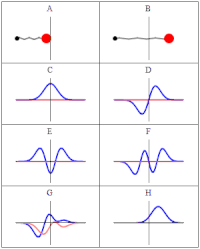
Photo from wikipedia
It is well known that the use of the primitive second-order propagator in path-integral Monte Carlo calculations of many-fermion systems leads to the sign problem. This work will show that… Click to show full abstract
It is well known that the use of the primitive second-order propagator in path-integral Monte Carlo calculations of many-fermion systems leads to the sign problem. This work will show that by using the similarity-transformed Fokker-Planck propagator, it is possible to solve for the ground state of a large quantum dot, with up to 100 polarized electrons, without solving the sign problem. These similarity-transformed propagators naturally produce rotational symmetry-breaking ground-state wave functions previously used in the study of quantum dots and quantum Hall effects. However, instead of localizing the electrons at positions that minimize the potential energy, this derivation shows that they should be located at positions that maximize the bosonic ground-state wave function. Further improvements in the energy can be obtained by using these as initial wave functions in a ground-state path-integral Monte Carlo calculation with second- and fourth-order propagators.
Journal Title: Physical review. E
Year Published: 2020
Link to full text (if available)
Share on Social Media: Sign Up to like & get
recommendations!